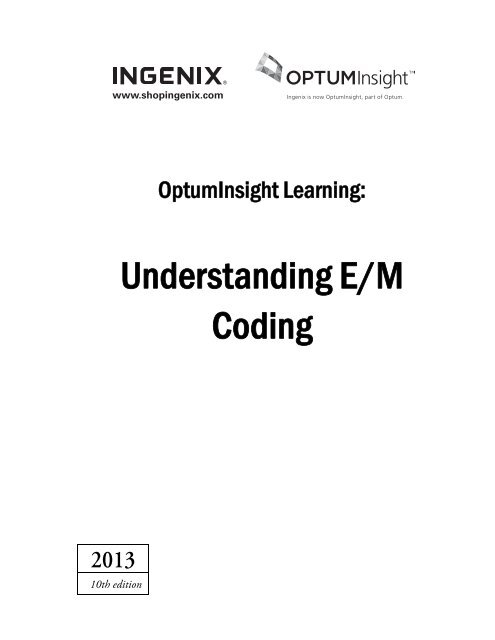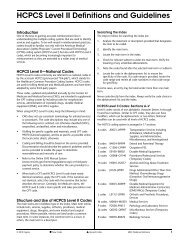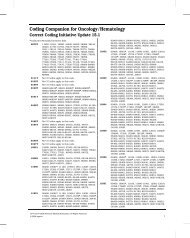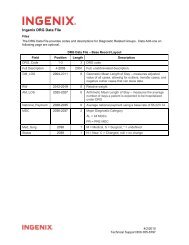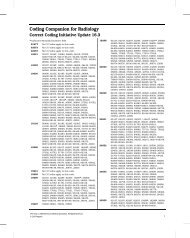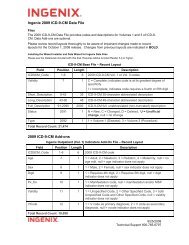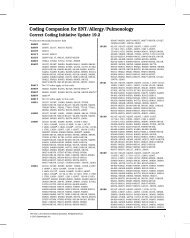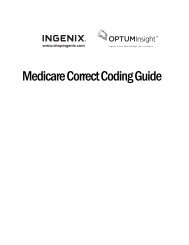Understanding E/M Coding - OptumCoding.com
Understanding E/M Coding - OptumCoding.com
Understanding E/M Coding - OptumCoding.com
Create successful ePaper yourself
Turn your PDF publications into a flip-book with our unique Google optimized e-Paper software.
OptumInsight Learning:<strong>Understanding</strong> E/M<strong>Coding</strong>201310th edition
PUBLISHER’S NOTICEIngenix Learning: <strong>Understanding</strong> E/M <strong>Coding</strong> is designed tobe an accurate and authoritative source regarding coding andevery reasonable effort has been made to ensure accuracy and<strong>com</strong>pleteness of the content. However, Ingenix makes noguarantee, warranty, or representation that this publication isaccurate, <strong>com</strong>plete, or without errors. It is understood thatIngenix is not rendering any legal or other professionalservices or advice in this publication and that Ingenix bearsno liability for any results or consequences that may arisefrom the use of this book. Please address all correspondenceto:Ingenix2525 Lake Park BlvdWest Valley City, UT 84120AMERICAN MEDICAL ASSOCIATION NOTICECPT codes, descriptions, and other CPT material onlycopyright 2010 American Medical Association. All RightsReserved. No fee schedules, basic units, relative values, orrelated listings are included in CPT. AMA does not directlyor indirectly practice medicine or dispense medical services.AMA assumes no liability for data contained or notcontained herein.The responsibility for the content of any “Correct <strong>Coding</strong>Policy” included in this product is with the Centers forMedicare and Medicaid Services (CMS) and no endorsementby the AMA is intended or should be implied. The AMAdisclaims responsibility for any consequences or liabilityattributable to or related to any use, nonuse, or interpretationof information contained herein.CPT is a registered trademark of the American MedicalAssociation.OUR COMMITMENT TO ACCURACYIngenix is <strong>com</strong>mitted to producing accurate and reliablematerials.To report corrections, please visit www.ingenixonline.<strong>com</strong>/accuracy or email accuracy@ingenix.<strong>com</strong>. You can also reachcustomer service by calling 1.800.INGENIX (464.3649),option 1.ACKNOWLEDGMENTSJulie Orton Van, CPC, CPC-P, Product ManagerKaren Schmidt, BSN, Technical DirectorStacy Perry, Manager, Desktop PublishingLisa Singley, Project ManagerNannette Orme, CPC, CCS-P, CPMA, CEMC,Clinical/Technical EditorTemeka Lewis, MBA, CCS, Clinical/Technical EditorTracy Betzler, Desktop Publishing SpecialistKate Holden, EditorAbout the Technical EditorsNannette Orme, CCS-P, CPC, CPMA, CEMC,Clinical/Technical EditorMs. Orme has more than 15 years of experience in the healthcare profession. She has extensive background in CPT/HCPCS and ICD-9-CM coding. Her prior experienceincludes physician clinics and healthcare consulting. Herareas of expertise include physician audits and education,<strong>com</strong>pliance and HIPAA legislation, litigation support forMedicare self-disclosure cases, hospital chargemastermaintenance, workers' <strong>com</strong>pensation and emergencydepartment coding. Ms. Orme has presented at nationalprofessional conferences and contributed articles for severalprofessional publications. She is a member of the AmericanAcademy of Professional Coders.Temeka Lewis, MBA, CCS, Clinical/Technical EditorMs. Lewis is a clinical/technical editor for Ingenix withexpertise in hospital and physician coding. Her areas ofexpertise include ICD-9-CM, CPT, and HCPCS coding. MsLewis' past experience includes conducting coding audits andphysician education, teaching ICD-9-CM and CPT coding,functioning as a member of a revenue cycle team,chargemaster maintenance, and writing <strong>com</strong>pliancenewsletters. Most recently she was responsible for coding and<strong>com</strong>pliance in a specialty hospital. She is an active member ofthe American Health Information Management Association(AHIMA).COPYRIGHT© 2012 OptumMade in the USAISBN 978-1-60151-428-8
ContentsChapter 1: Introduction ....................................................... 1Contents ..................................................................2How to Use <strong>Understanding</strong> E/M <strong>Coding</strong> .................4Knowledge Assessment .............................................7Chapter 2: The Building Blocks of E/M <strong>Coding</strong> .................... 9Levels of E/M Services ..............................................9Component Sequence and Code Selection .............10Key Components ....................................................13Terms Commonly Used in E/M Codes ..................25Modifiers Used with E/M Codes ...........................27Selecting an E/M Code ...........................................28Knowledge Assessments ..........................................29Chapter 3: The Elements of Medical Documentation ......... 31Principles of Documentation ..................................32Evaluating Your Documentation ............................33The SOAP Format ................................................33The SNOCAMP Format ........................................34Audit Considerations in Documentation ................36Knowledge Assessments ..........................................38Chapter 4: Adjudication of Claims by Third-PartyPayers and Medicare ........................................................ 39Medically Necessary Services ..................................39Documentation Policy Under theMedicare Program ...........................................42Teaching Physician Documentation .......................43Incident-to Services ................................................43Physician Quality Reporting System .......................43Comprehensive Error Rate Testing (CERT)Program ..........................................................46Knowledge Assessments ..........................................48Chapter 5: Office or Other OutpatientServices (99201–99215) ................................................. 49New Patient (99201–99205) ..................................49General Guidelines .................................................49Issues in This Code Range ......................................51Established Patient (99211–99215) ........................64General Guidelines .................................................64Issues in This Code Range ......................................65Chapter 6: Hospital Services (99217–99239) ................... 77Initial Hospital Observation and Discharge Services(99217–99220) ...............................................77General Guidelines ................................................77Issues in This Code Range ......................................78Subsequent Hospital ObservationServices (99224—99226) ................................87Quick Comparison .................................................87General Guidelines .................................................87Issues in This Code Range ......................................88Initial Hospital Care (99221–99223) .....................95General Guidelines .................................................95Issues in This Code Range ......................................96Subsequent Hospital Care and HospitalDischarge Services (99231–99239) ................105General Guidelines ...............................................105Issues in This Code Range ....................................106Chapter 7: Consultations (99241–99255) ......................121Office or Other Outpatient Consultations(99241–99245) .............................................121General Guidelines ...............................................121Inpatient Consultations (99251–99255) ...............134General Guidelines ...............................................134Chapter 8: Other Hospital–Based Services(99281–99292) .............................................................147Emergency Department Services, New or EstablishedPatient (99281–99288) .................................147General Guidelines ...............................................147Issues in This Code Range ....................................149Critical Care Services (99289–99292) ..................161General Guidelines ...............................................161Chapter 9: Residential Care Services(99304–99340) .............................................................165Nursing Facility Services (99304–99318) .............165Initial Nursing Facility Care (99304–99306) ........165General Guidelines ...............................................165Issues in This Code Range ....................................166Subsequent Nursing Facility Care(99307–99318) .............................................173General Guidelines ..............................................173Issues in This Code Range ....................................174Domiciliary, Rest Home, or Custodial CareServices—New Patient (99324–99328) .........181General Guidelines ...............................................181Domiciliary, Rest Home, or Custodial CareServices—Established Patient(99334–99337) .............................................187General Guidelines ...............................................187Issues in This Code Range ....................................187© 2012 OptumCPT only © 2011 American Medical Association. All Rights Reserved.i
Ingenix Learning: <strong>Understanding</strong> E/M <strong>Coding</strong>Domiciliary, Rest Home (e.g., Assisted Living Facility),or Home Care Plan Oversight Services(99339–99340) .............................................193General Guidelines ...............................................193Chapter 10: Home Services (99341–99350) ...................195New Patient (99341–99345) ................................195General Guidelines ...............................................195Established Patient (99347–99350) ......................201General Guidelines ...............................................201Issues in This Code Range ....................................201Chapter 11: Prolonged Physician Services(99354–99359) .............................................................207Prolonged Physician Service with Direct(face-to-face) Patient Contact(99354–99357) .............................................207General Guidelines ..............................................207Prolonged Physician Service Without Direct(face-to-face) Patient Contact( 99358–99359) ............................................211General Guidelines ...............................................211Chapter 12: Other E/M Services (99363–99456) ............213Anticoagulant Management (99363–99364) ........213General Guidelines ...............................................213Medical Team Conferences (99366-99368) ..........214General Guidelines ...............................................214Care Plan Oversight Services (99374–99380) .......215General Guidelines ...............................................216Preventive Medicine Services(99381–99429) .............................................217General Guidelines—Preventive MedicineServices .........................................................217Issues in These Code Ranges .................................217Non-Face-to-Face Physician Services(99441–99444) .............................................220General Guidelines ...............................................220Special Evaluation and Management Services(99450–99456) .............................................221General Guidelines ...............................................222Issues in This Code Range ................................... 222Chapter 13: Newborn and Pediatric Services(99460–99480) ............................................................. 223Newborn Care Services (99460–99465) ............... 223General Guidelines .............................................. 223Issues in This Code Range ................................... 223Other Evaluation and Management Services ........ 224General Guidelines .............................................. 224Transport Critical Pediatric Patient(99466–99467) ............................................ 225General Guidelines .............................................. 225Neonatal and Pediatric Inpatient Critical Care(99468–99476) ............................................ 227General Guidelines .............................................. 227Intensive Critical Care—Initial and Continuing(99477–99480) ............................................ 229General Guidelines .............................................. 229Chapter 14: Knowledge Assessments with Answers ......... 231Chapter 1 ............................................................. 231Chapter 2 ............................................................. 231Chapter 3 ............................................................. 232Chapter 4 ............................................................. 232Appendix A: Physician E/M Code Self-Audit Forms ......... 233Appendix B: Crosswalk for 1995 and 1997 E/MDocumentation Guidelines .............................................. 243Appendix C: 1997 Evaluation and ManagementDocumentation Guidelines .............................................. 257Appendix D: Summary of the 2011 OIG Work Plan .......... 277Glossary ......................................................................... 281Index .............................................................................. 291ii© 2012 OptumCPT only © 2011 American Medical Association. All Rights Reserved.
Chapter 4: Adjudication of Claims by Third-Party Payers and MedicareTEACHING PHYSICIAN DOCUMENTATIONTeaching physicians and residents may both chart on the same patient. However, ateaching physician who is billing Medicare must personally document “his or herparticipation in the management of the patient.” This includes managing the patientor being present during the critical or key portions of the patient care. (Guidelines forTeaching Physicians, Interns, and Residents, July 2007, ICN: 006347, pages 2–3) Thestatement that “the resident’s certification that the attending physician was present isnot sufficient” helps to clarify the level of documentation required by the teachingphysician.Students may document in the medical record. However, the teaching physician canrefer only to the portion “related to a review of systems and/or past, family, and/orsocial history.”INCIDENT-TO SERVICESIncident-to ProtocolsIf the practice employs limited-licensed practitioners, it is advisable to periodicallydetermine that the “incident-to” guidelines are being adhered to. Incident-to servicesare defined by the Centers for Medicare and Medicaid Services as “those services thatare furnished incident to a physician professional services in the physician’s office(whether located in a separate office suite or within an institution) or in a patient’shome.”To qualify as incident-to, the services must be part of the patient’s normal course oftreatment, during which a physician personally performed an initial service andremains actively involved in the course of the patient’s treatment. The physician doesnot have to be physically present in the treatment room while these services areprovided but must be present in the office suite to render assistance, if necessary(direct supervision). The patient record should document the essential requirementsfor incident-to services.In other words, the medical records should document the following:• The service was an integral part of the patient’s treatment course.• The service is <strong>com</strong>monly included in the physician’s services.• The service is furnished in a physician’s office or clinic (not in an institutionalsetting).• The service was an expense to the practice.Examples of qualifying incident-to services include cardiac rehabilitation, providingnon-self-administrable drugs and other biologicals, and supplies usually furnished bythe physician in the course of performing his or her services (e.g., gauze, ointments,bandages, and oxygen).It is important to note that the Office of the Inspector General (OIG) work planshave included reviews of incident-to-services in recent years. These reviews areongoing and may take several years to <strong>com</strong>plete.☛ KEY POINTThe Physician Quality ReportingSystem (PQRS) was formerlyreferred to as the Physician QualityReporting Initiative (PQRI).PHYSICIAN QUALITY REPORTING SYSTEMThe Physician Quality Reporting System (PQRS) measures were developed by theCenters for Medicare and Medicaid Services in cooperation with consensus© 2012 OptumCPT only © 2011 American Medical Association. All Rights Reserved. 43
Ingenix Learning: <strong>Understanding</strong> E/M <strong>Coding</strong>QUICK TIPModifiers 25, 32, and 57 are to beappended to the E/M code and notto the codes for the otherprocedures or services that may beperformed.• When a <strong>com</strong>mon chart is used, a separate report to the requesting provider doesnot need to be sent. Examples of a <strong>com</strong>mon chart include large multispecialtyclinics with electronic medical records.• Use the appropriate office consultation code if the consultant was asked againfor an opinion or advice regarding the same problem or a new problem.• Assign the appropriate critical care code instead of these codes if the physicianprovided constant attention to a critically ill patient.• Assign the appropriate office visit code if the patient or family member and notanother physician (or appropriate source) requested the consultation.• Do not consider the time spent by other staff (e.g., nurse) as part of theface-to-face time.• Report 99354–99359 for E/M services that run 30 minutes beyond the typicaltime specified in the code narrative. The time must be clearly documented inthe medical record.• Add modifier 25 to report that a separately identifiable E/M service was performedby the same physician on the same day as a procedure or service. Onlythe work involved in the separate E/M service should be considered when determiningthe correct level of service.• Use modifier 32 when the services were mandated, such as by a third-partypayer, or as a result of a governmental, legislative or regulatory requirement.• Add modifier 57 to indicate that the decision to perform major surgery hasbeen made.• Report separately the codes for the diagnostic tests or studies performed.• Codes for high-level E/M services have been targeted in the CERT program asbeing overutilized. Medical necessity and the level of medical decision makingshould be verified for all high-level E/M services.• Follow-up visits initiated by the physician consultant or patient are reportedwith the appropriate site-of-service codes (e.g., office visits) for establishedpatients. However, if an additional request is documented in the record for anadditional opinion or advice for the same or separate problem, the consultationcodes may be reported again.• Transfer-of-care services (for either specific condition or the patient’s entirecare) are reported with the appropriate new or established patient codes for thesite of service.• Medicare does not accept consultation codes. Report outpatient consultationswith the appropriate E/M service code for the site of service and new or establishedpatient.99241DOCUMENTATION REQUIREMENTSMedical Decision Making: straightforward• Minimal number of diagnoses or management options considered• No or minimal amount and <strong>com</strong>plexity of data reviewed• Minimal risk of <strong>com</strong>plications or morbidity or mortalityProblem Severity: minor or self-limited• Little, if any, risk of morbidity without treatment© 2012 Optum122 CPT only © 2011 American Medical Association. All Rights Reserved.
Chapter 7: Consultations (99241–99255)• Little, if any, risk of mortality without treatment• Transient problem, low probability of permanently altered status• Good prognosisHistory: problem focused• Chief <strong>com</strong>plaint• Brief history of present illness or problem (one to three HPI elements)Examination: problem focused• 1995: one organ system or body area• 1997: one to five bullet (•) elements in one or more organ systems/body areasCode Indicators (from tables of risk—including some AMA indicators in italic)Presenting Problem(s)• One self-limited or minor problemManagement Options• Rest, gargles, elastic bandages, superficial dressingsCounseling and/or Coordination of Care• As appropriate for the problemTime Spent Face to Face (average)• 15 minutesSample Documentation—99241Level I Office/Outpatient ConsultationTO: Dr. Attending PhysicianFROM: Dr. ConsultantThis 26-year-old female is seen at the request of Dr. Attending Physician to evaluate a lump the patientfound in her right breast. She states that she found the mass three days ago during a regular, monthly selfexamination. She states that the mass is “a little sore.” She has had no such masses before; no history ofinjury to the area. No other significant past history. No family history of breast cancer.Menses are regular, and the patient is “within a couple of days” of beginning her menses.The patient is not on oral contraceptives or other medications.Px: BP 120/80, respirations l8, temperature 98.7, pulse 65. Neck shows no masses or palpable nodes.Breasts are small, symmetrical and generally nontender. There is a small, 1.5-cm nodule palpable in theright inner quadrant; it is easily movable, well circumscribed and feels cystic. There are no other masses.No nipple discharge or other abnormalities. No axillae lymphadenopathy.Assessment: Cyst of breast, rightRe<strong>com</strong>mendation: Patient was reassured that this mass is probably a cyst and not likely to bemalignant, and this seemed to relieve her anxiety. We discussed the possibility of fine-needle aspiration ofthe cyst. The patient, however, indicates that she is “very afraid” of needles and prefers not to have thisprocedure done today. Because of the patient’s concern over aspiration, I re<strong>com</strong>mend ultrasound todistinguish simple vs. <strong>com</strong>plex cyst. She agrees to the ultrasound, which our office will schedule.Thank you for asking me to see your patient. I re<strong>com</strong>mend that we proceed with the needle aspiration in thenear future if the ultrasound shows the cyst to be suspicious.(Single organ system—GYN)QUICK TIPThe consulting provider initiated adiagnostic procedure and madefollow-up re<strong>com</strong>mendations basedupon the out<strong>com</strong>e of the testing.© 2012 OptumCPT only © 2011 American Medical Association. All Rights Reserved. 123
Appendix C: 1997 Evaluation and Management Documentation GuidelinesRespiratory ExaminationSystem/Body AreaElements of ExaminationConstitutional • Measurement of any three of the following seven vital signs: 1) sitting or standing blood pressure, 2)supine blood pressure, 3) pulse rate and regularity, 4) respiration, 5) temperature, 6) height, 7) weight (May bemeasured and recorded by ancillary staff).• General appearance of patient (e.g., development, nutrition, body habitus, deformities, attention to grooming)Head and FaceEyesEars, Nose, Mouth and Throat • Inspection of nasal mucosa, septum and turbinates• Inspection of teeth and gums• Examination of oropharynx (e.g., oral mucosa, hard and soft palates, tongue, tonsils and posterior pharynx)Neck • Examination of neck (e.g., masses, overall appearance, symmetry, tracheal position, crepitus)• Examination of thyroid (e.g., enlargement, tenderness, mass)• Examination of jugular veins (e.g., dissension; a, v or cannon a waves)Respiratory • Inspection of chest with notation of symmetry andexpansion• Assessment of respiratory effort (e.g., intercostal retractions, use of accessory muscles, diaphragmatic movement)Respiratory• Percussion of chest (e.g., dullness, flatness, hyperresonance)(continued)• Palpation of chest (e.g., tactile fremitus)• Auscultation of lungs (e.g., breath sounds, adventitious sounds, rubs)Cardiovascular • Auscultation of heart with notation of abnormal sounds and murmurs• Examination of peripheral vascular system by observation (e.g., swelling, varicosities) and palpation (e.g., pulses,temperature, edema, tenderness)Chest (Breasts)Gastrointestinal (Abdomen) • Examination of abdomen with notation of presence of masses or tenderness• Examination of liver and spleenGenitourinaryLymphatic • Palpation of lymph nodes in neck, axillae, groin and/or other location.Musculoskeletal • Assessment of muscle strength and tone (e.g., flaccid, cog wheel, spastic) with notation of any atrophy or abnormalmovements• Examination of gait and stationExtremities • Inspection and palpation of digits and nails (e.g., clubbing, cyanosis, inflammation, petechiae, ischemia, infections,nodes)Skin • Inspection and/or palpation of skin and subcutaneous tissue (e.g., rashes, lesions, ulcers)Neurological/ Psychiatric • Brief assessment of mental status including:• orientation to time, place and person• mood and affect (e.g., depression, anxiety, agitation)Content and Documentation RequirementsLevel of ExamProblem focusedExpanded Problem focusedDetailedComprehensivePerform and DocumentOne to five elements identified by a bullet.At least six elements identified by a bullet.At least twelve elements identified by a bullet.Perform all elements identified by a bullet; document every element in each shaded box and at least one element ineach unshaded box.© 2012 OptumCPT only © 2011 American Medical Association. All Rights Reserved. 275


